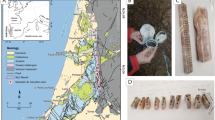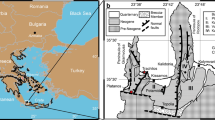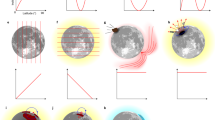Abstract
THE inclination error (δ) in sediment is the difference between the inclination of the ambient field and that of the remanent magnetization acquired by a sediment1. The error is reckoned positive (negative) if the inclination of remanence is less (greater) than that of the field. Inclination errors in nature may be studied by comparing observed inclinations in sedimentary rocks (Io) with that expected (Ie) from studies of contemporaneous isotropic igneous rocks which are not subject to the error. There are two methods. Results from nearby localities may be compared directly (method 1), or results from widely spaced localities may be compared by calculating the expected inclination (Ie) calculated from the palaeomagnetic pole derived from observations of igneous rocks with the observed inclination (Io) in sediments (method 2). Method 2 assumes that the Earth's field is a geocentric dipole. Both methods assume that the secular variation is averaged out so that only averages for formations covering many tens of thousands of years may be used. There are errors (α) in determining Ie and I0 so the inclination error is itself subject to error. Because of the statistical inhomogeneity of the palaeomagnetic data a formal calculation of the error in δ would be unrealistic, but a lower limit is set by the α values. In simple observations of fossil remanence a is usually about 10°, whereas after the application of magnetic or thermal cleaning techniques accuracies of about 5° can sometimes be achieved.
This is a preview of subscription content, access via your institution
Access options
Subscribe to this journal
Receive 51 print issues and online access
$199.00 per year
only $3.90 per issue
Buy this article
- Purchase on Springer Link
- Instant access to full article PDF
Prices may be subject to local taxes which are calculated during checkout
Similar content being viewed by others
References
King, R. F., Mon. Not. Roy. Astr. Soc. Geophys. Suppl. 7, 115 (1955).
van Andel, S. I., and Hospers, J., Nature, 212, 891 (1966).
Irving, E., J. Geophys. Res., 71 (1966).
Irving, E., and Parry, L., Geophys. J., 7, 395 (1963).
Irving, E., J. Geophys. Res., 68, 2283 (1963).
Robertson, W. A., J. Geophys. Res., 68, 2299 (1963).
Opdyke, N. D., J. Geophys. Res., 69, 2495 (1964).
Gough, D. I., Brock, A., Jones, D. L., and Opdyke, N. D., J. Geophys. Res., 69, 2499 (1964).
Opdyke, N. D., J. Geophys. Res., 66, 1941 (1961).
Opdyke, N. D., Glass, B., Hays, J. D., and Foster, J., Science, 154, 349 (1966).
Nankovitch, D., Opdyke, N. D., Heezen, B. C., and Foster, J. H., Earth Plan. Sci. Lett., 1, 476 (1966).
Author information
Authors and Affiliations
Rights and permissions
About this article
Cite this article
IRVING, E. Evidence for Palaeomagnetic Inclination Error in Sediment. Nature 213, 483–484 (1967). https://doi.org/10.1038/213483a0
Received:
Issue Date:
DOI: https://doi.org/10.1038/213483a0
Comments
By submitting a comment you agree to abide by our Terms and Community Guidelines. If you find something abusive or that does not comply with our terms or guidelines please flag it as inappropriate.



